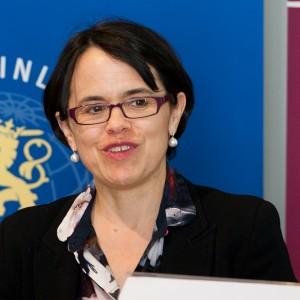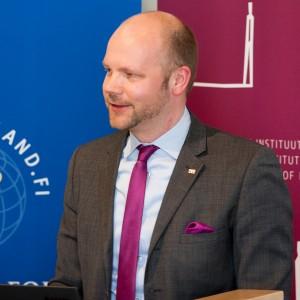Responsibility to Protect has matured from a contested principle to concrete protection of humans in situations of atrocity. The practical implementation of RtoP raises difficult and multifaceted questions about the goals, means and the role of various actors. Although the primary duty to human protection lies with States, organizations on a regional and national level are important agents in the implementation of the principle. Such actors can address specific needs and interests within their own field of expertise thereby consolidating the principle globally. How do various organizations translate the principle of RtoP into practice? How can civil society contribute to human protection? Is there a risk for fragmented and diffuse approaches to RtoP? The aim of the seminar is to bring together various experts and stakeholders to present and discuss policy options and challenges in implementing RtoP.
Opening remarks:
Teija Tiilikainen, Director, the Finnish Institute of International Affairs
Keynote Speaker:
Jennifer Welsh, Special Adviser for the Responsibility to Protect to the UN Secretary-General
Jennifer Welsh is Special Adviser for the Responsibility to Protect to the UN Secretary-General and Professor in International Relations at the University of Oxford and a Fellow of Somerville College. As a Special Adviser Ms. Welsh works to further the conceptual, political, institutional and operational development of the responsibility to protect concept. Her current research projects include the evolution of the notion of the ‘responsibility to protect’ in international society, the ethics of post-conflict reconstruction, the authority of the UN Security Council, and a critique of conditional notions of sovereignty. She has a BA from the University of Saskatchewan, and a Masters and Doctorate from the University of Oxford.
Speakers:
Neil Buhne, Director, Bureau for Crisis Prevention and Recovery (BCPR) Geneva Liaison Office, UNDP
Jani Leino, Legal Advisor, Finnish Red Cross
Chair:
Katja Creutz, Senior Research Fellow, the Finnish Institute of International Affairs
Further information:
Sannamari Bagge, tel. +358 9 4327711, sannamari.bagge@fiia.fi
Summary of the seminar
FIIA Director Teija Tiilikainen opened the seminar co-organised by FIIA and the Finnish Ministry for Foreign Affairs focusing on the Responsibility to Protect (RtoP). The principle was adopted in 2005 by the United Nations member states. They thus affirmed their duty to protect their populations from atrocities. The UN Security Council has confirmed this commitment in several resolutions. The seminar would examine questions such as: How to translate the principle into practice? Who should have this responsibility? What is the role of states and of other actors?
Special Adviser Jennifer Welsh thanked the organisers and said she appreciates Finland’s efforts for the advancement of RtoP. This principle boils down to a simple assertion: there is collective responsibility to protect populations from genocide, crimes against humanity, war crimes and ethnic cleansing. This responsibility rests first and foremost with sovereign states. But outside actors also have a duty to assist states in their primary task (this is the so-called second pillar of RtoP). If the state is failing in its responsibility, outsiders have a protection role. The RtoP notion was first articulated by the International Commission on Intervention and State Sovereignty (ICISS) in its 2001 report ‘The Responsibility to Protect’ that drew heavily on work done at the Brookings Institution by Francis Deng, former Adviser for the Prevention ofGenocide. He developed an important notion: sovereignty as responsibility, which means that responsibility is an inherent part of the role of sovereign states. However, states can and should interact in partnership with outside actors in fulfilling those responsibilities.
RtoP took on momentum through former UN Secretary-General Kofi Annan’s reform efforts in 2004-5. It was endorsed unanimously at the 2005 World Summit of the UN, where heads of state and heads of government affirmed the existence of this responsibility. According to the Summit Outcome Document, RtoP includes the prevention of atrocity crimes, including incitement. But they also agreed that the international community should help states to exercise this responsibility. Should the state fail to protect its population, heads of state and government agreed to act together through a variety of means. This was almost a decade ago. Since then, there have been efforts to implement RtoP based on a 2009 report by the Secretary-General. Special Adviser Welsh mentioned the creation of the Joint Office and a convening mechanism to bring senior officials together in crisis situations, as well developing relations with regional organisations, including the EU. There is also a vibrant civil society constituency, and a growing body of applied multi-discipline research on the risk factors for the four crimes at the heart of RtoP. In addition, RtoP has been evoked by a number of bodies, including the UN Security Council, the Human Rights Council, and the General Assembly, in connection to crises in Yemen, South Sudan, Libya, and the Central African Republic. In April 2014, the Security Council unanimously adopted a historic resolution marking the 20 years since the Rwandan genocide, Resolution 2150.
Special Adviser Welsh admitted that there are challenges around this still young principle. She identified four challenges: first of all, despite being a multifaceted agenda, the implementation of RtoP is still often associated with the use of military force, and mistakenly seen as belonging only to the UN Security Council, which often acts inconsistently given its veto power and political nature. This inconsistency is addressed even in the Summit Outcome document. While we acknowledge this reality at the Secretariat, we need to try to be absolutely consistent, calling for action in situations where atrocity crimes are committed or are imminent, Special Adviser Welsh stated.
Another challenge has to do with the varying regional and subregional interpretations of the principle, and divergent use of terminology. Some regions think of RtoP in the framework of mass atrocity or genocide prevention; Latin American countries in particular are active in building national mechanisms for this purpose.
Thirdly there is the difficulty in mobilising the UN and other organisations for preventive or early action. It is difficult to prove the effectiveness or preventive action, but there are also sensitivities around many forms of preventive action. While there is very strong commitment within the UN system and elsewhere to prevention, there is a lack of willingness to do the analysis needed for prevention to work. It is difficult to have issues come on the agenda of the Security Council; some threats are discussed and others are not. Whether it is the situation in the Central African Republic, Burundi, or the 2013 Kenya elections, it is difficult to have the Council discuss an issue in a preventive sense. Although the Joint Office has recently had some success in using more informal Arria-formula meetings of the Council, prevention remains a challenge.
And finally, RtoP is still too often a UN discourse. More work is needed particularly with respect to regional organisations which should have a pivotal role under the second pillar, international assistance to states. Special Adviser Welsh described the work of the Joint Office: the conceptual and operational development of RtoP and contributing to its implementation, issuing statements, field presence and capacity building. She also mentioned the yearly reports of the Secretary-General and dialogues in the General Assembly regarding states’ responsibility and the support of the international community. In focusing on pillar 2, this year’s report will emphasise that protection must be carried out in partnership. RtoP is designed to support states, affirming their sovereignty, not to judge them from outside. The goal should be to create resilient, inclusive, and transparent societies that can work in partnership to prevent these crimes.
The 2013 report lists actual things states can do: they can create national mechanisms for atrocity prevention like the Focal Points Initiative, conduct national risk assessments, ratify legal instruments to combat impunity, participate in peer-review processes, and participate in discussions. Finland has contributed in terms of advocacy and intellectual support, through its interest e.g. in mediation.
This year marks the 20th anniversary of the Rwandan genocide. The inability and unwillingness of outside actors to prevent this tragedy has motivated people to build a culture of “never again”. It has not fully succeeded, as we can see in e.g. South Sudan and the Central African Republic. The motivation and capacity for atrocity crimes remains, and many countries are too weak to prevent them. Nevertheless, we have come a long way in 10 years, Special Adviser Welsh argued. Prior to the war in the Balkans, it was commonplace that actors denied that serious human rights violations were a matter for international concern. Thanks in part to the RtoP this has changed.
After the presentation, questions were asked regarding the intervention in Libya versus no intervention in Syria, and the possible consequences of RtoP in cases like Kosovo.
In his speech, Neil Buhne explained that UNDP’s mission is to promote social progress and better standards of life, but its work is closely linked to other parts of the UN Charter: the prevention of wars and the respect of human rights and international law. Much of their work is consistent with pillars 1 and 2 of RtoP, even if this is not explicitly stated. The actions taken by UNDP are de facto about preventing conditions where terrible things could happen. UNDP’s latest strategic plan from 2013 focuses on many of these issues. UNDP aims for inclusive and sustainable growth, stronger systems of democratic governance, universal access to basic services and gender equality. Countries should be able to reduce risks of conflict and to recover from them quickly. Mr Buhne cited successes that UNDP and other agencies have contributed to, in Kenya, Côte d’Ivoire, Liberia and Sierra Leone, even in Afghanistan.
However, the example of South Sudan shows that there are many barriers to contributing to pillars 1 and 2 of RtoP. One of the problems is that development actors tend to think that development alone is the answer. Secondly, we work based on agreement with governments, and sometimes we are pushed back, Mr Buhne said, referring to his experience in Sri Lanka as an example. The third obstacle is a lack of interest on the part of donors for preventive or post-conflict programmes. According to Mr Buhne, even humanitarian assistance can be a barrier. Although it can prevent the worsening of crises if used correctly, in some cases it can have a too narrow focus. Another challenge is the dialogue around terrorism: there are many limitations on agencies’ involvement with organisations classified as terrorist, but more engagement for instance with the Sri Lankan rebel movement may have prevented further violence, Mr Buhne argued. One barrier is caused by differences within the UN. And finally, the language of RtoP can be misused in domestic contexts. By contrast, the communities of people themselves can often be enablers of prevention, he said, and reminded of the importance of post-crisis work. On a more optimistic note, Mr Buhne talked about initiatives and programmes that contribute to RtoP. Even if the world is perhaps becoming less violent, he hoped that the fairly small investments needed for countries to meet their responsibilities are made and barriers reduced.
Jani Leino began by saying that RtoP has no relevance as a concept for the Red Cross and Red Crescent Movement and for the International Committee of the Red Cross (ICRC). And yet, especially the first two pillars are their bread and butter. The movement acknowledges an obligation to ensure respect of international humanitarian law. This means for instance making sure that weapons are not sold to those who will use them to commit atrocity crimes.
What is protection? There are different interpretations of the concept of protection of civilian population. The problem is that the distinctions are not being made, when we talk about neutral independent humanitarian action. The Red Cross is not enthusiastic about a comprehensive approach to conflict management, because they know from the field the problems that arise when working with different actors. Military actors use coercive measures, whereas humanitarian actors use non-coercive measures. Other humanitarian actors have a different approach than the ICRC. The Red Cross talks about civilians, prisoners of war, the sick and wounded, and the right for them to get medical care.
In the protection framework, UN peacekeeping operations, regional organisations, non-state actors, and UN special agencies all have their own role to play. The Red Cross cannot e.g. prosecute anyone, but it has other means. Mr Leino agreed that the work done after a crisis is important. The ICRC perspective to protection is that it has an exclusively humanitarian mission to protect the lives and dignity of victims of armed conflict and other violence, and provide assistance. It aims to prevent suffering by promoting and strengthening humanitarian law and principles. Impartiality, neutrality, and independence are absolute prerequisites for fulfilling its mandate.
The ICRC definition of protection is close to the concept of RtoP: it aims to ensure that states and non-state actors live up to their obligations. It needs the consent of the state in order to work on the field. The Red Cross engages in environment building, responsive action and remedial action. But in addition to humanitarian work, the ICRC’s mandate is also about engaging with parties to the conflict and reminding them of their responsibilities. As for modes of action, the Red Cross prefers persuasion and dialogue to denunciation. Another mode is mobilisation, which can mean advocating, going to third parties in order to influence them. Mr Leino said we cannot talk about RtoP without talking about accountability and sanctions. The ICRC also conducts research on the causes of war and atrocity crimes.
While RtoP as a concept does not give much to the Red Cross, it is good if it pushes states to ensure respect. Problems are not solved by making new laws, but by developing mechanisms to enforce the law. Political will is needed for developing a democratic, inclusive society. The Red Cross is not very enthusiastic about being associated with the very politicised concept of RtoP. As an example, Mr Leino referred Libya, where it would be difficult to work if the Red Cross were to be identified with RtoP, which in that context meant NATO bombs.
FIIA Senior Research Fellow Katja Creutz, who chaired the session, thanked the speakers for pointing out the work done by organisations that qualify under RtoP without using the same words. She noted that Mr Leino also touched on two important issues: a possible risk of fragmentation, and possible problems caused by competing understandings of RtoP. This is related to the indeterminate, broad nature of the principle. Ms Creutz invited the other speakers to comment. Jennifer Welsh pointed out that RtoP refers to atrocity crimes even outside of armed conflicts. She also said that humanitarian action is not threatened only by the association with RtoP, but by other developments.
Finally, the speakers answered audience questions. It was discussed whether the inclusion of post-conflict and preventive action is broadening the RtoP principle too much. Another question concerned role of regional and subregional organisations, and how they compare.



